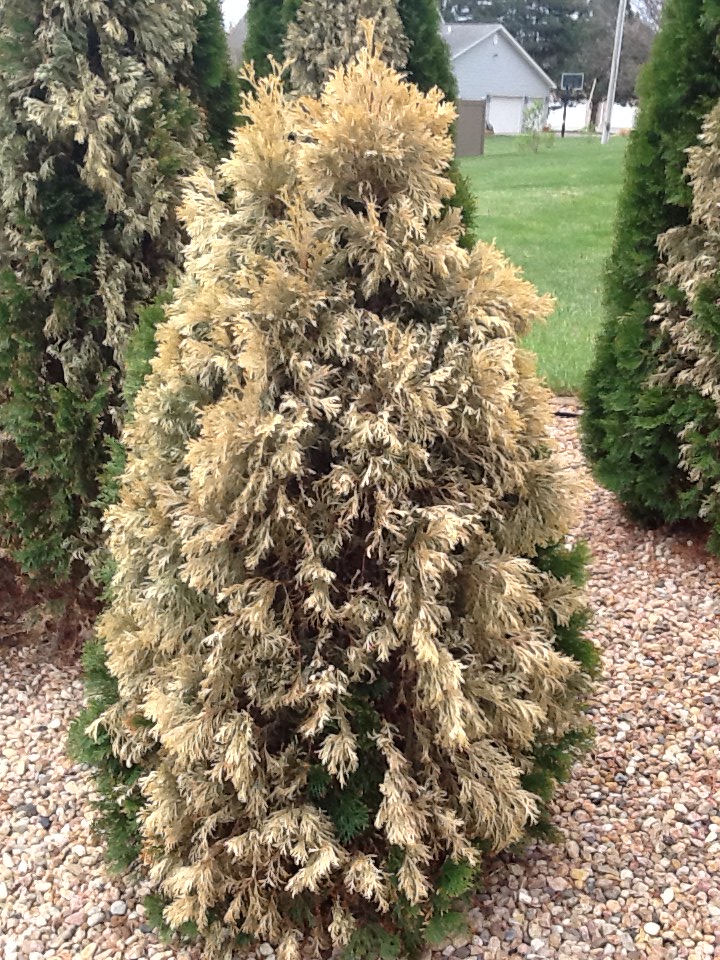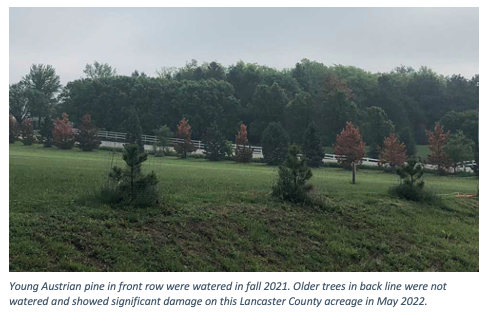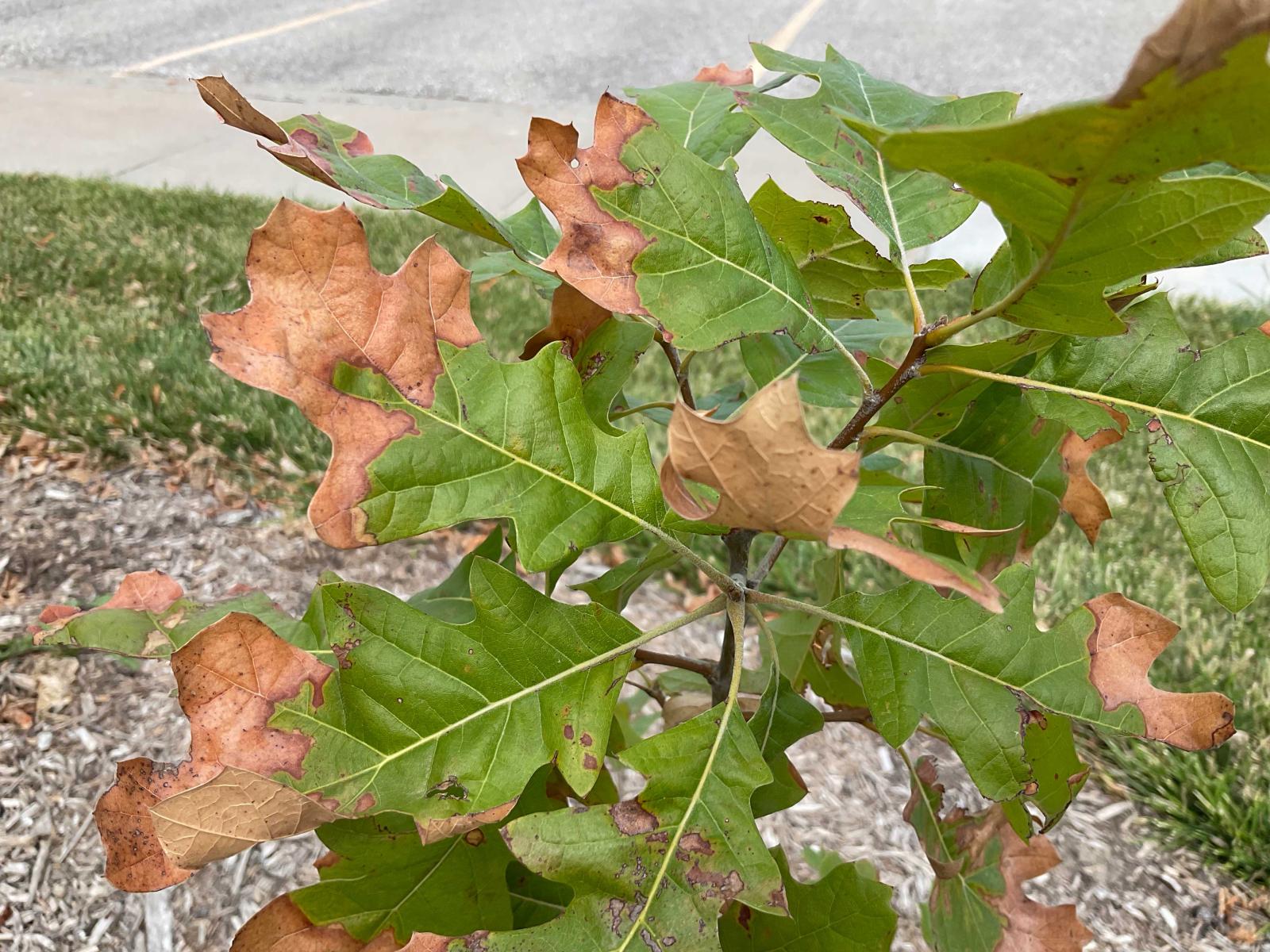Summer 2022 was hot! The Lincoln area had 66 days of 90+ F days from May through September 30. And this was often coupled with very windy conditions! In unwatered portions of the landscape many gardeners saw lawns turning brown, soil pulled away from driveway and sidewalk edges, and possibly even scorch symptoms in trees. These are all good indications when our our landscapes are dry. For a current look at Lincoln drought status, visit U.S. Drought Monitor.
In fall, warm dry days with cool nights usually lead to great fall leaf coloration, but dry fall conditions have a downside, too.
Fall is a time for plants to replace the moisture reserves lost during our hot dry summer periods. But if dry conditions continue in fall little recovery is possible. Drought stressed trees are more susceptible to secondary attack by insect pests and disease problems, such as borers and cankers, which can cause tree death. Healthy trees, receiving adequate water, are much more resistant to pest problems.
One common symptom of drought stress is leaf scorch, a uniform yellowing or browning on leaf edges of broadleaf plants or the tips of evergreen needles. However, even trees that don’t exhibit leaf scorch are likely experiencing drought stress now.
And finally, trees and shrubs that are not fully hydrated going into winter are prone to winter desiccation, a common type of winter injury that occurs when the amount of water lost by plants exceeds the amount picked up by the roots.
Young or newly planted trees and shrubs are most susceptible to drought injury, because they have not yet established the extensive root system needed to draw moisture from the soil during dry conditions.
 What is Winter Desiccation?
What is Winter Desiccation?
All trees lose water during normal metabolic processes, even in winter. In summer, when woody plants have a full canopy of foliage, large amounts of water are lost through their leaves. During winter months, photosynthetic processes are slowed, especially for deciduous plants that drop their foliage, but they still lose water through exposed bark, twigs and buds. Evergreen trees and shrubs, as well as broadleaf evergreen plants like holly or mahonia, are very prone to winter desiccation because they lose water at a higher rate through their foliage.
Warm, sunny days or windy conditions during winter increase the amount of water lost. If the soil is frozen or soil moisture is low due to dry winter conditions, plant roots may be unable to pick up enough water to meet its needs. Evergreen needles dry out and die, either partially or completely, but they may hold their green color until warmer temperatures arrive in spring, thus delaying the onset of browning symptoms.
Winter wind accompanying dry periods can accelerate water loss from the needles, resulting in more severe needle damage or death on the side of the tree facing the prevailing wind.
Each spring many homeowners find dead, brown foliage on their evergreen plants, particularly arborvitae and boxwood, but sometimes also pine, spruce, fir, juniper and yew. The extent of the symptoms can vary from brown needle tips on one side of the plant, to one or two branches, to the whole tree. Injury is found on the outer portion of the branches and is often most severe on the side of the tree facing the wind or a source of radiated heat, such as a south or west-facing brick wall or street.
Winter desiccation symptoms seen in spring include brown foliage on evergreens, particularly arborvitae, boxwood and holly, but sometimes also pine, spruce, fir, juniper and yew. The extent of the symptoms can vary from brown needle tips on one side of the plant, to one or two branches, to the whole tree. Injury is found on the outer portion of the branches and is often most severe on the side of the tree facing the wind or a source of radiated heat, such as a south or west-facing brick wall or street.
 Eight-month Drought
Eight-month Drought
Dry conditions from September 2021 through April 2022 resulted in damage or death to many plants with symptoms showing up in early spring 2022. Aside from the common winter-damage susceptible plants mentioned above, we unexpectedly saw damage in eastern red cedar and spruce in windbreaks.
Fortunately, plant damage or death from dry conditions is preventable. Deep-watering plants in fall during dry periods may mean the difference between healthy vigorous trees, shrubs and ornamentals or stressed struggling plants next spring.
 Repairing Summer Drought Stress Under Dry Fall Conditions
Repairing Summer Drought Stress Under Dry Fall Conditions
Since Nebraska frequently experiences dry summer, fall and early winter conditions, deep-watering trees in fall can mean the difference between healthy, vigorous trees or stressed, struggling trees next spring.
Begin by applying a 3-6 foot diameter ring of mulch around the base of trees and shrubs, with 3-4 inches of an organic material, like coarse wood chips, to help conserve soil moisture. Make sure it's a flat layer of mulch, not piled up like a volcano against the plant's bark. Keep it far enough away that it doesn't touch the tree's trunk.
During fall, plants should receive one inch of water per week, either through irrigation or rain. If rain doesn't come, plan to water trees.
In eary fall, for mature established trees, when conditions are dry and temperatures are in the 80s F, two deep soakings per month is usually adequate for mature trees. Apply water deeply, moistening the soil to a depth of about 12-18 inches. Use a long-bladed screwdriver or piece of rebar to check the depth of water penetration. Once you've reached dry soil, it will be much harder to push the probe into the ground. Water the entire area underneath the tree’s drip-line if possible.
When temperatures cool off into the 70s F or below, aim for one deep soaking per month.
If using a sprinkler, let it run in a low pattern in one area until the top 12-18 inches of soil is moistened then move it as needed to water the entire area underneath the tree’s canopy or over a shrub’s root zone. Or coil a soaker hose several times around the tree from the trunk to the dripline, and let it run until the soil is moistened.
Care of New Plants
Trees, shrubs and ornamentals recently planted or transplanted need extra attention. Make sure new plants are mulched as described above. Research has shown a 2-3 inch application of wood chip mulch nearly doubles plant growth in the first few years after planting by eliminating competition from weeds or grass and conserving soil moisture.
Tree roots, especially the small, water-absorbing roots, are easily damaged during transplanting. For sufficient water uptake to occur, the root ball of a newly planted tree must be kept moist, but not saturated. Monitor the moisture in the root ball daily, and water as needed so it doesn’t dry out. The best way to do this is by sticking your finger into the soil of the root ball to feel for moisture level. When watering, be sure to moisten the area outside the root ball too, this encourages root growth into surrounding soil.
A watering basin two to three inches deep and three to four feet in diameter, created around the base of young trees will hold water until it can percolate into the soil. Or 5-gallon buckets, with holes in the base, can be used to irrigate small trees.
Final Tips
Here are a few final things to keep in mind to make your landscape plants as healthy as possible this fall.
Don't fertilize now. Trees and shrubs need to become hardened off before going into winter. Succulent, new growth resulting from fertilization is much more susceptible to winter burn.
Don't do any pruning of woody plants until they are dormant. Pruning is an invigorating process which stimulates new growth. Whenever pruning is done during the growing season, new growth will quickly follow.
Late summer/early fall pruning of evergreens, such as yew or boxwood, and spring or summer-flowering shrubs leads to the development of new growth. It takes time for this new growth to harden off and develop full cold hardiness, making the new growth very prone to damage from freezing temperatures in October/November or winter injury. If pruning needs to be done before winter, wait until plants are dormant.
The EXCEPTION to this rule is removal of dead, diseased or damaged branches; this can be done at any time.
Images by Sarah Browning, Nebraska Extension Educator
- Feature image - needles scorch on white pine.
- Winter desiccation injury on arborvitae.
- Difference in winter survival among young and old windbreak trees based on fall watering. Image used with homeowner permission.
- Leaf scorch on young black oak tree.
- New growth on yew shrubs developed in response to fall pruning and killed by cold temperatures.